To Libya and Back: Inside a Stealth Bomber Strike Against ISIS

An MQ-9 Predator soars high above the camp, the camera in its sensor ball fixed on the Islamic State fighters below. The foot soldiers are unloading rocket-propelled grenades and artillery shells from the backs of pickup trucks, likely unaware of the American unmanned aircraft overhead. Still, their fear of prying aerial eyes is noticeable as they stretch tarps across vehicles to obscure their shapes from above.
This ISIS encampment is one of several in the desert southwest of the Libyan city of Sirte. Late last year, U.S. warplanes helped local forces drive ISIS from the city. Some of those fighters have regrouped in these camps, others have gathered here from elsewhere. There are more than 100 Islamic State fighters spread across these sites.
It's mid-January and the presidency is days away from a change in administration. The U.S. ended combat in Sirte a month earlier. Now, ISIS fighters are regrouping in a familiar place when they feel safe from U.S. intervention.
They are mistaken.
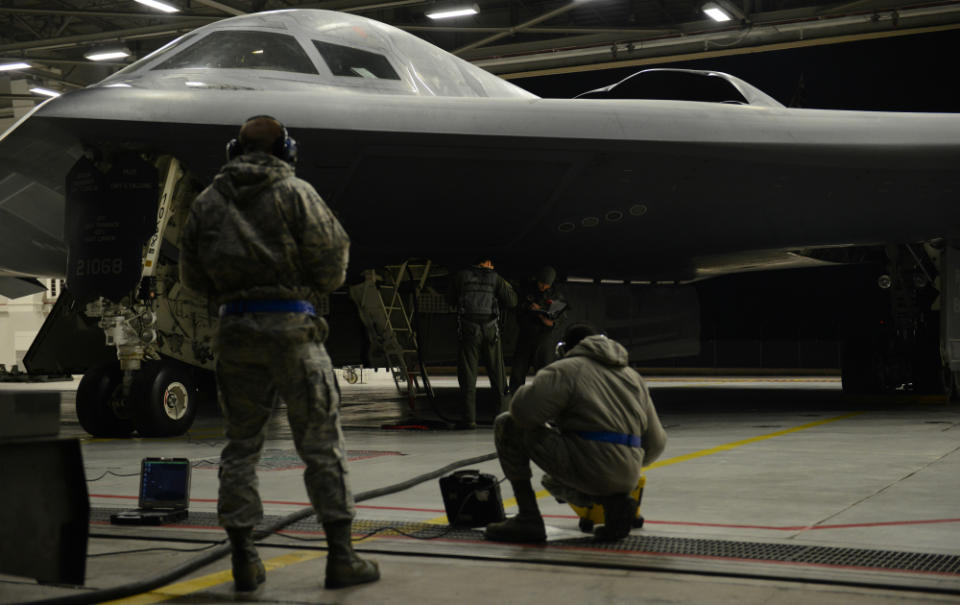
Half a world away, "Scorch" climbs into the cockpit of a B-2 stealth bomber.
He's got a tough job, in some ways tougher than what's facing the pilots who will fly the actual mission. Scorch needs to prep the airplane for the strike at the Libyan ISIS camps, some 5,700 miles away.
It will take about 32 hours to fly from Whiteman Air Force Base in Missouri to the target in Libya and then return home. The pilots doing that need all the rest they can get. To trim the mission time, other B-2 pilots like Scorch assist with flight planning, weapons pre-checks, and sometimes even starting the engines.
"Of all the pilots on the base, 75 percent knew about the mission or were part of it," Scorch tells PM. "The others had no reason to know and had to find out about it like everyone else-from CNN."
"Every B-2 pilot on the base wanted to go on this mission."
The Air Force does not disclose the names of pilots, and does not allow those in the cockpit to discuss the strikes themselves. But Scorch (who earned his callsign due to an incident with an overheated B-2 engine) and others at the base and within Global Strike Command agreed to speak with Popular Mechanics about how a globe-spanning airstrike is planned and executed.
"Every B-2 pilot on the base wanted to go on this mission," Scorch says. "Myself included."
[contentlinks align="left" textonly="false" numbered="false" headline="Related%20Story" customtitles="Year%20One:%20Inside%20the%20Air%20War%20Against%20ISIS" customimages="" content="article.17383"]
The mission is easy to describe, but hard to execute. Two B-2 Spirit bombers, each with two people in the cockpit, will take off, fly to the target, drop enough bombs to eradicate the ISIS camps, and immediately fly back home to Missouri. Things get more complex as planners weigh in on everything from the pilot's diets to the size of the bombs loaded in the airplane.
"It takes a symphony of people," says Major General Scott Vander Hamm, assistant deputy chief of staff of operations at the Air Force headquarters and a former B-2 pilot.

The intelligence staff of U.S. Africa Command (AFRICOM) has been monitoring the ISIS camps for weeks before the White House gives them the go-ahead.
While working out the finer diplomatic details, the military continues planning. "There are times when the President says, 'This is what we want. This is the objective, tell us how you could do it,'" Hamm says during an interview with PM days after the strike. "That was the case for last week's flights."
Gen. Thomas Waldhauser, AFRICOM commander, chooses the B-2-an odd choice. The stealth bombers are built for a Cold War mission: to evade radar and drop bombs (even atomic) and get out undetected. No one in Libya has sophisticated anti-aircraft to threaten U.S. aircraft, so the stealth is not necessary.
But a bomber is an absolutely essential part of the equation. Nothing else can drop thousands of pounds of explosives on targets at the same time quite like a bomber. The U.S. bomber fleet includes non-stealth B-1s and B-52s, but it's the B-2s that can loiter for long stretches. Just because the B-2 can stay over a target doesn't mean the pilots want to. "We are versatile," Scorch says. "But it's always in the back of all of our minds to get in and get out."
The targets define what aircraft flies the mission, and 500-pound bombs are all that is needed to take out a collection of mud-walled buildings and unarmored vehicles.
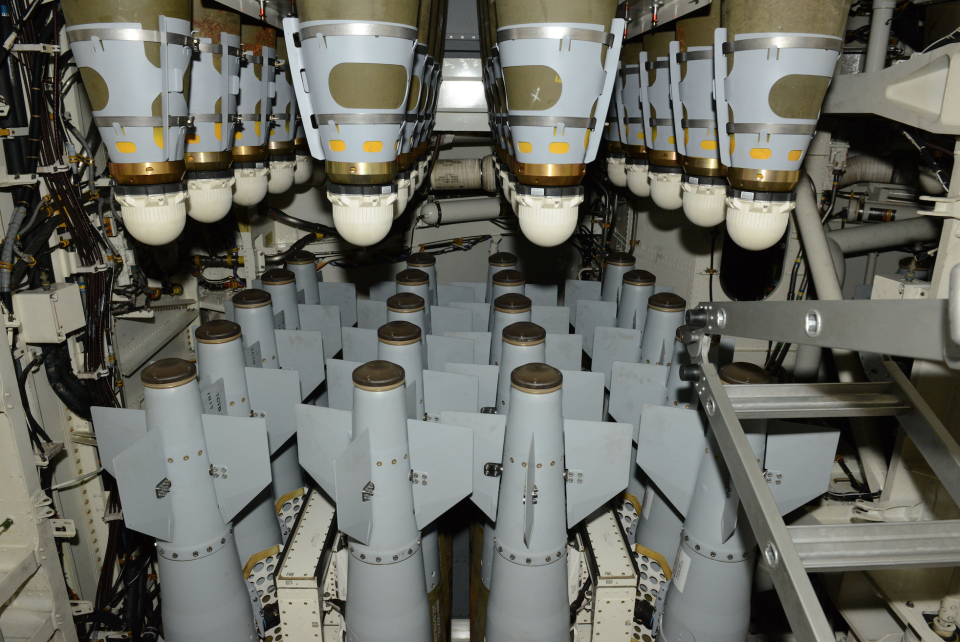
The weapon loaders can mix and match smaller and heavier bombs, but Hamm says the Libya mission B-2s carry a "homogenous loadout" of 500-pound bombs. The B-2 can carry 80 of these 500-pound bombs, each guided to detonation with GPS coordinates. Each of the bombs can be programmed to hit a specific target, at a specific altitude, from a specific angle, at a specific time. "These were pretty tight shot groups, and the B-2s could attack them on a single pass," Hamm says.
Although the targets are pre-programmed, B-2 pilots also program coordinates from the cockpit. Nearly every training sortie includes some on-the-fly retasking of weapons. Hamm, who served as a B-2 pilot, says he once received a last-second orders to spare a target in Iraq that was providing the coalition with signals intelligence.
Each of the bombs can be programmed to hit a specific target, at a specific altitude, from a specific angle, at a specific time
But this ISIS attack isn't a typical B-2 strike. Usually stealth bombers knock down defenses and allow other, non-stealth aircraft to strike undefended targets. Instead, these two B-2s will strike the camps, wait overhead for an assessment of the damage, and then retask their remaining bombs to hit anything that's still standing. In Air Force parlance, this mission will be two parts "deliberate" (pre-planned) and one part "dynamic."
"Hopefully we make it as vanilla as possible," Scorch says. "But even when there's nothing dynamic, nearly every combat mission I've heard of, there has been some changes."
Whiteman Air Force Base is the home of the B-2 bomber fleet.
There are only 20 of these stealth bombers in the hands of the U.S. Air Force arsenal.
B-2 bomber crews come from nearly every Air Force discipline. Pilots start their careers with other bombers. Some hail from the fighter community while others flew cargo haulers and tankers before coming to the Spirit.
The cycle of training, maintenance, and rest comes to halt when the base receives a planning order. "That's the first time when we know something is happening," Hamm says. The staff first selects pilots, then develops a concept of operations, reaches out to others involved in an operation like refueling tankers, and reports the options up the chain as high as the secretary of defense and the president.
Although this mission will only fly two B-2s, each with a two-man crew, many more are made ready to fly. "Two or three times that number are briefed up and ready to go, " Hamm says. "They go on dry runs in the simulators, show up for the tech ops briefings, mission plans, and get on crew rest."
These pilots are more than understudies. As the mission's takeoff time creeps closer, these backups will take on portions of the planning and preparation to enable the actual pilots to prepare for the rigors of a long duration flight.
"The sooner we get the tasker the better it is," says Maj. Danny Elich, a medical services flight commander for the 509th Bomb Wing and an aerospace physiologist. "We can start reshifting the crews and synchronizing their circadian rhythms."
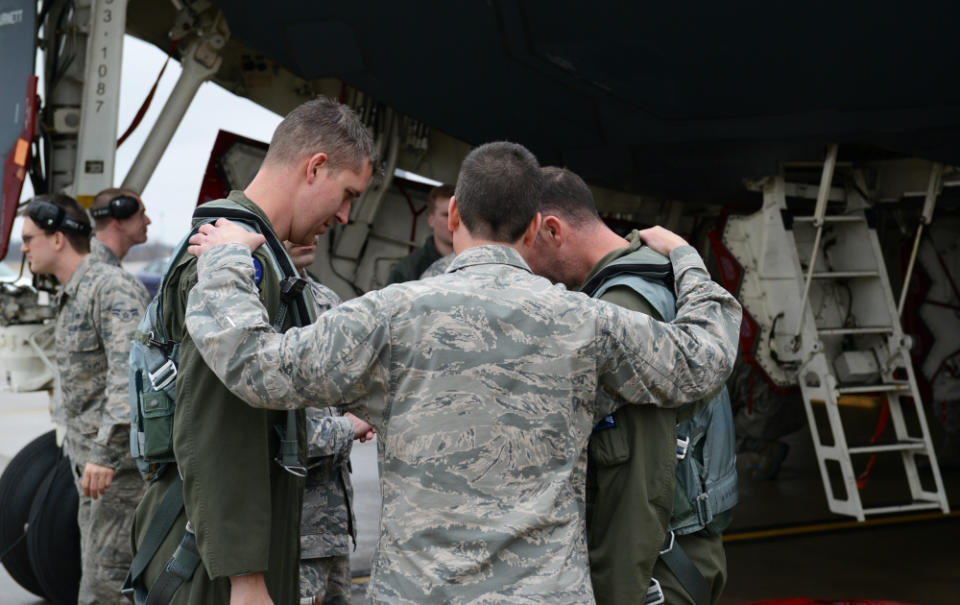
These long flights play hell with the pilots' sleep and waking cycles. There are also issues with dehydration, deep vein thrombosis, and fatigue. To combat this, the physiologists at Whiteman plan their own version of the mission, including snacks and nap times that preserve the two-man crew for the moments of intense concentration. They also recommend, and sometimes require, the use of "go pills" (often Dexedrine) or "no go pills" (something akin to Ambien) to enforce the rest cycle as a last resort.
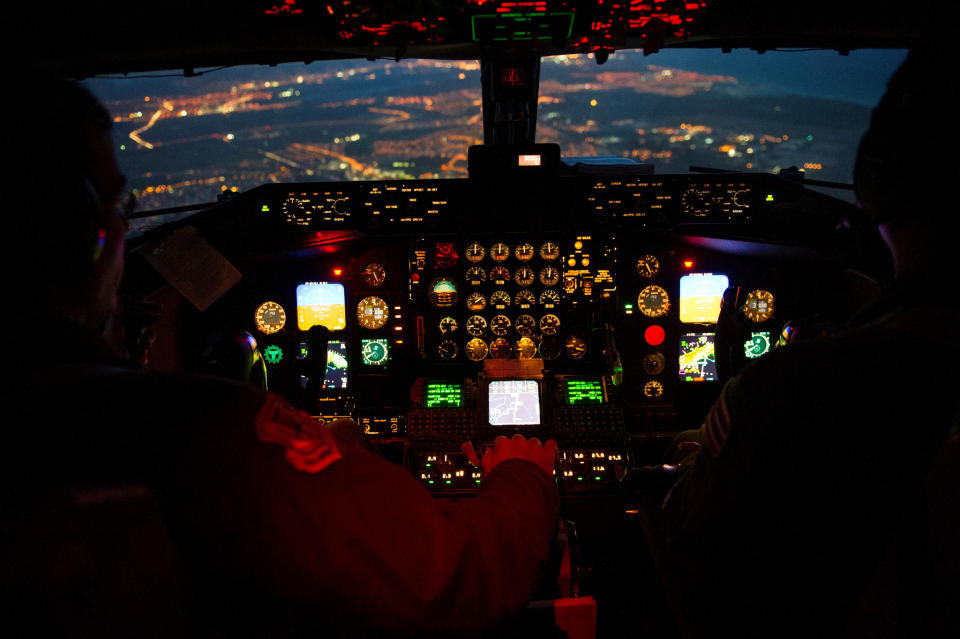
Long-range bombing missions include equally long lulls in the cockpit, an experience far removed from comfy first-class flying.
Behind two seats is a 6-foot flat space where pilots can set up a cot to sleep. Behind the right seat is a crude toilet-a stainless-steel bowl with no walls-not too far from a bank of classified communications servers.
But these long flights also come with too much free time, which can lead to stress and nerves. Most pilots try to use the time constructively. "On the way out you're worried about getting your tactics right," says Scorch. "I try to use the time to study, to brush up on the mission. I also get up from the chair as much as I can, do pushups or exercises."
Others use the time to reflect. "You go over it," Hamm says of his combat missions. "Am I right with God, my family, my life, and my will?"
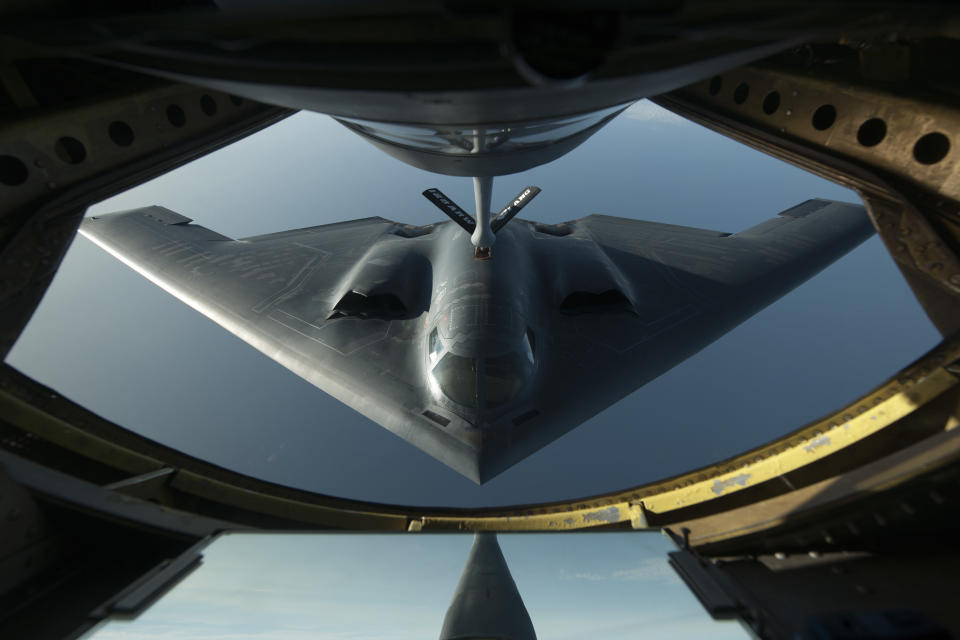
Eventually, it's time to refuel. The B-2s meets KC-135 Stratotankers at least twice on the way to Libya. It's a coordinated dance that must occur no matter what the weather or time of day. The airplane in need of fuel flies directly behind the tanker. The tanker then extends a telescoping fueling boom. The end of the boom-the fuel nozzle-latches into a small hole in the receiving aircraft, and the fuel pumps as the conjoined aircraft fly in harmony.
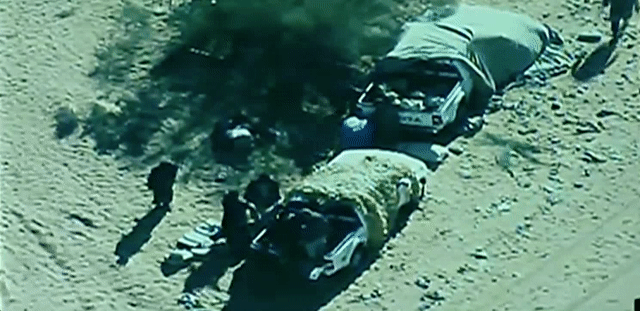
The B-2's fuel port is on top of the fuselage, so a pilot can't tell how close the boom is to the bomber's receptacle. They watch lights under the tanker plane's fuselage that tell him to move forward, left, or right. Once the connection is made, a dashboard screen says "LATCH" and the fueling begins. As thousands of gallons of flow, the B-2s flight control computer routes it to the appropriate tanks as a way to preserve the bomber's center of gravity.
Then its back to the long wait as two B-2s inch closer to their Libyan targets. "The stakes are really high," Hamm says. "You can't train for that piece."
The deadly math of this airstrike requires two B-2s to release around 500-pound bombs to on the first pass.
With 80 stacked and ready in each bomb bay, both B-2s will attack the target and have bombs to spare if anything is left standing.
Bombing runs are preprogrammed events-all part of the flight plan. The bomber calculates the time of release at the particular airspeed and automatically opens the bomb bay doors to release the weapons from either a rotary launcher or a bomb rack. "We can drop within a few feet of a target, if not right on it," Hamm says.
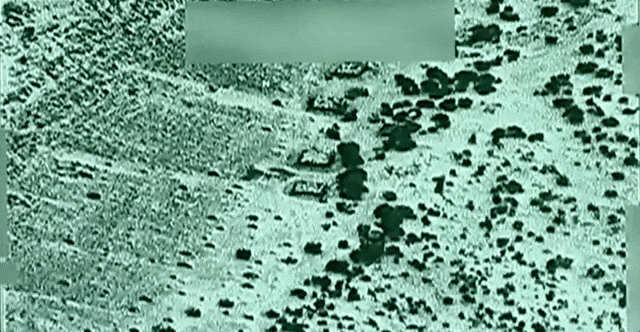
Over Libya, southwest of Sirte, the B-2s approach the targets. The B-2s open their bomb bay doors and the 500-pound bombs pour out. The big jet lurches as several thousand pounds of cargo is jettisoned in seconds. The bombs fall away without an explosive mechanism-gravity alone takes them from their assembly in the bomb bay. The airplane determines the airspeed, air density, and parameters that influence the drop and times the release.
Below the dark bombers, the ISIS fighters don't have any warning as thousands of pounds of explosives sails their way from above. At least one Predator is nearby to record the impact-a cacophony of overpressure blasts, roiling smoke and dust, and secondary explosions.
Dozens of ISIS fighters are killed. The Pentagon later gives a final tally at around 100.
The B-2s stay on station, waiting to hear word from AFRICOM of new GPS targets to program. The battle damage assessment is made. The Pentagon later indicates that the Predators fired a few Hellfire missiles at ISIS survivors, but the camps are devastated.
"There were a lot of eyes watching for activity," Hamm says. "But one pass was enough. And so they were sent home."

The way back has its own risks, fatigue chief among them.
The adrenaline of the bombing fades quickly, and the 18 hours back can be harder than any other part of the mission. "Now it's quiet and you have two or three hours until you even see a tanker," Hamm says. "This is generally the time when pilots have a tendency to get tired."
But there are two refueling encounters to go on the way home. By the time these happen, the pilots are eager to get home, get into U.S. airspace, and get the hell out of that cockpit.
Thirty-two hours after takeoff, the two B-2s land at Whiteman base, now filled with airmen and personnel that've heard about the strikes on television, while in Washington D.C., the Pentagon is briefing reporters. "This was a group that had plans. And that's why we struck them at this particular time," spokesman Peter Cook says, noting that the attack was coordinated with Libyan Government of National Accord. "This has been a discussion for some time as we've kept an eye on these particular camps."
Pilots and others at the base meet the crew, and not to just shake hands. They carry gear, help stow the jet, and do anything to help the exhausted pilots, who now face post-mission briefings with flight docs, commanders, and the crew chief.
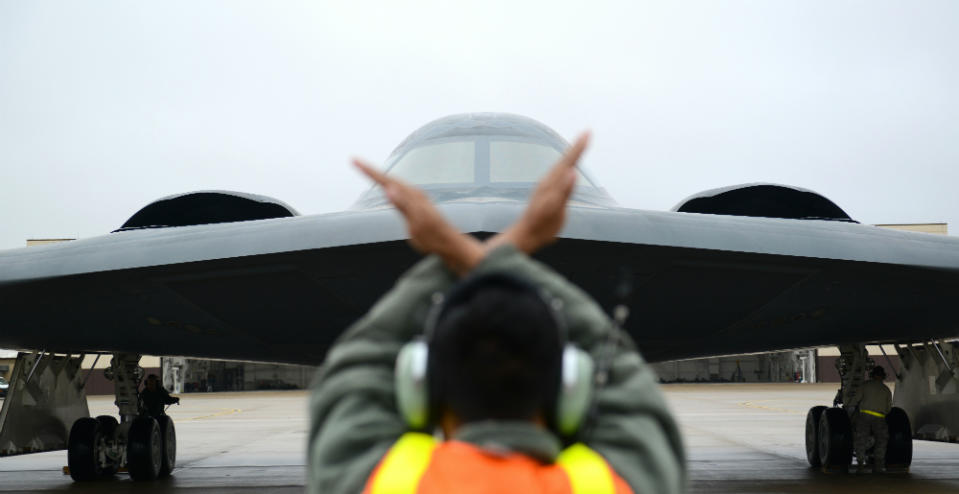
The physical effects of long-duration flights are debilitating, even with a cadre of well-trained, experienced fliers. "There have been times when you had to pour me from that cockpit," says Hamm, who flew 38-hour sorties in combat.
But finally the mission is over. Concerned crew chiefs scrutinize the bombers from the insides of the engines to the stealth coatings on the surface. The pilots are reintegrated into the squadron's sleep and rest rhythms-these pilots must always be ready to fly, as part of the nuclear triad as well as unexpected conventional bomb missions. Whiteman returns to relative normal, airplanes, crew, and commanders at the ready. The cycle resumes.
But sooner or later-whether weeks, months, or even years-the next planning order will come, and the B-2s and its crew will be called upon once again.

You Might Also Like

